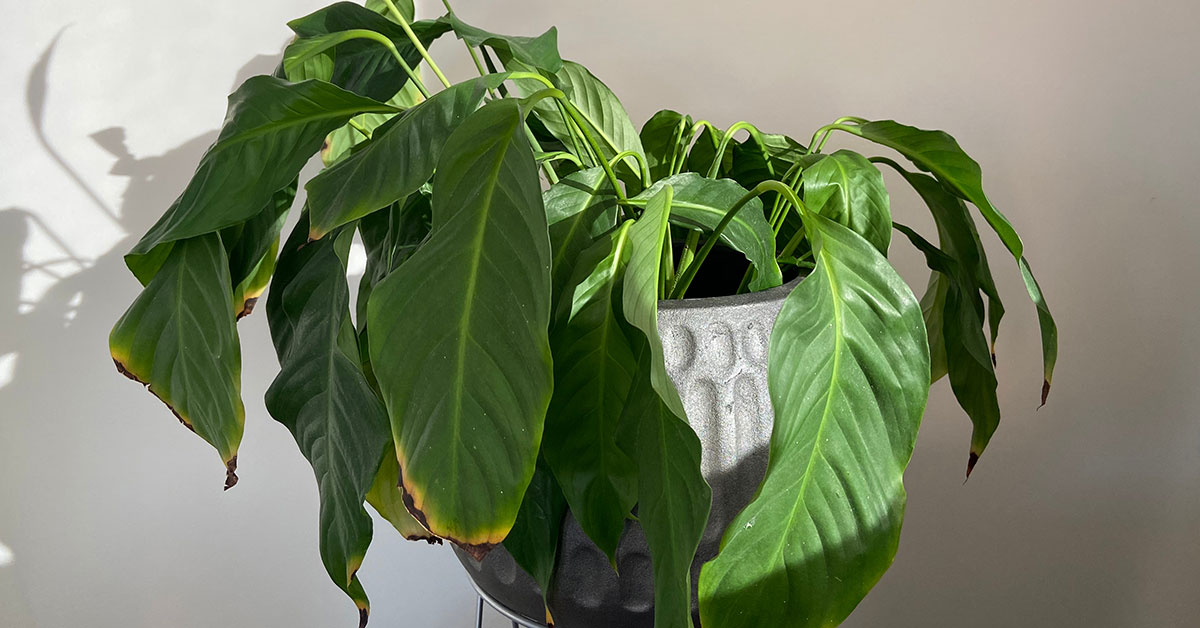Peace lilies, or Spathiphyllum, are popular houseplants due to their attractive white flowers and glossy green foliage. While they are quite resilient, they can sometimes droop, leading to concern among gardeners. Fortunately, there are many causes for a peace lily drooping or turning yellow as well as plenty of solutions to get them back to looking their best. In this article, we will discuss the causes of peace lilies drooping. Including how to revive them and prevent future drooping.
What Is A Peace Lily?
Peace lilies are an increasingly popular choice among many indoor gardeners and houseplant enthusiasts. They’re easy to grow and maintain, and their bright white blooms make them a beautiful addition to any home. Peace lilies are also considered to be one of the most effective air-purifying plants. Due to their natural ability to filter out harmful toxins from the air. Furthermore, they’re low-maintenance and can thrive in environments with little natural light. As such, peace lilies are an ideal choice for people who want to enjoy the benefits of greenery without too much effort.
Why Is My Peace Lily Drooping
Peace lily plants can droop if they are not given proper care. The most common reasons why peace lilies droop due to either too much or too little water, incorrect light levels, and nutrient deficiencies. Peace lilies need to be watered when the soil begins to dry, and not more than once a week. Too much water can lead to root rot and cause the leaves to droop. Peace lilies also need bright, indirect sunlight to thrive. If the plant is placed in too little or too much light, the leaves will become limp. Lastly, if the soil doesn’t have the right balance of nutrients, the peace lily can suffer from nutrient deficiencies, leading to drooping.
How To Treat Drooping Peace Lilies
In order to treat a drooping peace lily, it is important to first assess the reason for the drooping. If the plant is drooping due to a lack of watering, it should be watered thoroughly with lukewarm water. Allow it to drain before being placed back in its pot. If the drooping is due to overwatering, the soil should be allowed to dry completely before providing any additional water. Additionally, the peace lily should be placed in an area that receives indirect sunlight. Too much direct sun can cause the plant to droop. Finally, it is important to regularly clean the leaves of the peace lily with a damp cloth. This helps to remove any dust or dirt that may be preventing it from absorbing adequate sunlight.
Using The Right Kind Of Soil
To ensure the best growth and health of your peace lily, it is important to provide it with the right soil. The ideal soil for peace lilies is a light, peat-based potting soil that drains well and is slightly acidic. Be sure to mix in some perlite or vermiculite to increase drainage, and add a bit of slow-release fertilizer to the mix. Be sure to use a pot with drainage holes to help the soil dry out between waterings. When it comes to growing peace lilies, the right soil is essential for healthy growth.
These plants thrive in warm, humid environments, and prefer temperatures between 65-75 degrees Fahrenheit. For optimal growth, it is important to keep the temperature around these levels and avoid temperatures below 55 degrees Fahrenheit. If temperatures dip too low, the plant may become stressed and start to lose leaves. In addition, the peace lily should be kept away from overly warm temperatures, as this can cause the leaves to wilt or even die.
Mintor For Pests And Diseases
Unfortunately, peace lilies are prone to pests that can cause drooping leaves. Common pests include mealybugs, aphids, spider mites, and scale. Mealybugs and aphids both feed on the plant, sucking out its sap, which can cause the leaves to droop. Spider mites are tiny red or black mites that create webbing on the underside of the leaves and also feed on the plant sap. Scale are tiny pests that attach themselves to the plant and feed on the sap, which can also cause drooping leaves. All of these pests should be removed as soon as possible to prevent further drooping.
The most common disease that causes drooping peace lilies is root rot. This fungal disease is caused by overwatering or poorly draining soil, which creates an environment where fungi can thrive. Symptoms include the wilting and yellowing of leaves, stunted growth, and drooping of the plant. To prevent root rot, be sure to water only when the top inch of soil is dry, and use a pot with good drainage. If the plant is already affected, repot it in fresh soil and prune off affected parts. If you spot any signs of root rot, it’s important to act quickly to save your peace lily.
How To Prune Your Plant
Pruning your peace lilies can help ensure healthy growth and flowering. Begin by removing any dead or yellowing leaves. Use a pair of garden shears or scissors to trim off the leaves at the base, being careful not to damage the remaining foliage. Once the dead leaves are removed, you can begin to prune the stems of the peace lilies. Begin at the base of the plant and move up, cutting stems back to the desired size. The amount of pruning is dependent on the size and type of peace lily, so be sure to research the variety you are growing before pruning. Additionally, be sure to sterilize your pruning tools before and after use to prevent the spread of any diseases. With regular pruning, you can enjoy healthy, vibrant peace lilies for years to come.













